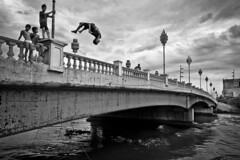I recently came across an article, that had a link to an article that I shared on Facebook. While I was scouring the deepest bowels of the internet on what to write, I came back to the article that I shared.
The article, titled 10 Photography Tips by Michelangelo's David, offered a brief story of the marble stone behind the famous Statue of David. That piece of marble represents every photograph taken but deemed "unsuitable" for sharing or printing. The marble stone shared a similar backstory to these photographs as it was once an abandoned project.
If you read the article, it advised the reader not to delete any photograph they took. It hit me hard, particularly because I, among many others are guilty of the crime. With the limited space in our hard drives, saving virtually every photo you took is close to impossible.
I took this advise as a challenge to incorporate my photography into Digital storytelling. A few words help give your photographs a back story, creating more context to the reader/viewer, while its linear form of storytelling makes it easier to plan shots.
Digital Storytelling is straightforward
Digital Storytelling is pretty linear. You can plot your story based on the sequence of shots taken from your camera. This also gives you more direction on what shots to take so you can incorporate it in your story (Also limits those macro shots, sunset shots and other shots you usually take to 1!).
Digital Storytelling trains you in creative captioning
Yes,a picture is worth a thousand words, but unless you are picturing World War III or any other event of great importance and significance, your readers might have little context of what's going on. Not all photos need captions, but I believe that some readers would appreciate a little backstory on your photos. Even the best photos found in magazines and newspapers are highlighted more with captions.
I like to come up with fun captions that can sum-up a thought or put an idea on my reader's head. These few words help invoke emotion to its viewers so choose it wisely.
This neophyte project of mine aims to help me keep all my "marbles" as well as show them to the world. (marbles I mean). They may not be Michelangelo's David yet, But these marbles all serve a purpose.
Heres the first Digital Storytelling Project I came up with from a short trip to the barber.
DIGITAL STORYTELLING: HAIRCUT
In preparation for a big trip, I was convinced to finally
have a change of hairstyle. Though I do go for haircuts
every now and then, It is rare that I come upon a change of hairstyle.
Compared to women who
could spend a week’s pay on hairstyles, many of us men are simpletons
who would prefer the cheaper 50 Peso (roughly 1 US Dollar) haircut.
Seeing as I might not see these overgrown locks again for the next few weeks, I
decided to bring my camera and narrate a short digital story.
In preparation for the World Cup Series, why not
get hair like this guy:
Yes, I am well aware of the fact that barbers and stylists can only give you a person's hair, and not their face, muscles, athletic ability or a Spice Girl wife. You can't expect too much from a $1 haircut so I wasn't.
What happened during the short walk to the barber? Scroll down bellow for the full story.
 |
| How many mannequin dolls do you see in a barbershop? Hopefully this wasn't a disgruntled customer. |
 |
| Three things you learn from your Father: How to shave How to tie a tie Never accept a free haircut |
 |
| You have to wait till your name is called from this guy. Lines are a good sign that barber shop may be good to you. |
 |
| Customer is either eager for his haircut or afraid for his life |
 |
| Same person during said haircut |
 |
| Viola! |
Hope you enjoyed the marbles. This is my first work on Digital Storytelling. Expect more posts on this in the future.
Did this article inspire you? We would love to hear your digital storytelling article, share it on the comments below!










